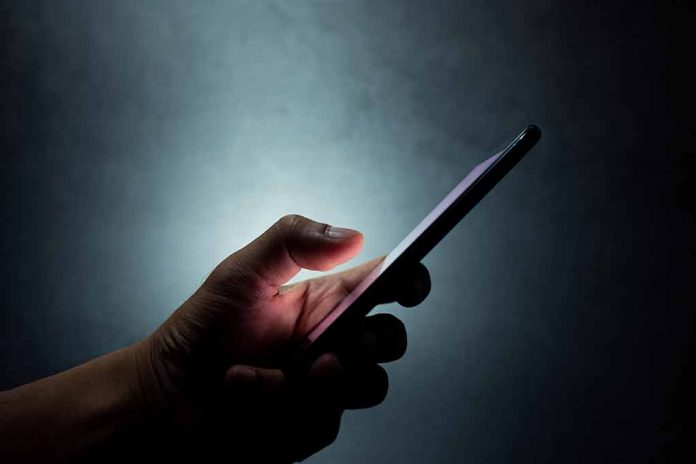
Texas lawmakers are tackling smartphone addiction in children with groundbreaking legislation aimed at reclaiming the minds of America’s youth from Big Tech’s manipulative grip.
Key Takeaways
- Texas passed laws requiring age verification and parental consent for app downloads by users under 18, shifting responsibility to app stores like Apple and Google.
- New “bell-to-bell no-cell” legislation mandates that public schools implement cell phone restrictions during school hours, with districts able to determine specific policies.
- Research shows that students spend approximately 1.5 hours on smartphones during the 6.5-hour school day, which significantly impacts learning and social development.
- Critics argue the legislation overemphasizes restrictions while underinvesting in digital literacy education that would teach children to navigate online spaces safely.
- Several Texas school districts have already implemented cell phone restrictions with positive results reported for student engagement and mental health.
Texas Takes On Big Tech With App Store Accountability
The Texas Legislature has positioned itself at the forefront of protecting children from digital addiction by introducing the App Store Accountability Act. This groundbreaking legislation targets the gatekeepers of the digital world—app stores operated by tech giants like Apple and Google—requiring them to implement age verification systems before allowing minors to download potentially harmful applications. The approach mirrors physical-world protections where ID checks are standard for purchasing age-restricted products, creating a digital equivalent of these safeguards for the online environment where children spend increasing amounts of time.
“We can no longer tolerate this as a society… If [these tech companies] can create it, they can prevent it. Come with solutions, or we’ll come up with solutions you won’t like,” said state Sen. Lois Kolkhorst.
Senate Bill 2420, introduced by Senator Paxton, seeks to codify these requirements into law. The legislation emerged after a joint committee hearing where experts, advocates, and victims provided testimonies highlighting alarming connections between social media usage and serious harms to children, including exposure to pornography, sex trafficking, and dangerous viral challenges. By focusing on app stores as what Federal Communications Commission Chairman Brendan Carr called “the single choke point,” the legislation aims to create an enforceable barrier between children and potentially harmful digital content.
Schools Implement “Bell-to-Bell No-Cell” Policies
Complementing the app store accountability measures, the Texas House passed a bipartisan bill, HB 1481, which requires public school districts across the state to restrict student cell phone use during school hours. This “bell-to-bell no-cell” approach gives districts flexibility in implementation while establishing a consistent statewide standard aimed at reclaiming classroom attention and improving educational outcomes. The legislation includes reasonable exceptions for health monitoring devices and accommodations for special education needs, ensuring that legitimate uses remain protected.
“Recent research from the American Medical Association’s Adolescent Health Journal shows that young students spend an average of 1.5 hours on smartphones during the 6.5-hour school day,” State Sen. Brandon Creighton stated during hearings on the bill.
Support for the measure crossed typical political divides, with State Sen. Paul Bettencourt declaring, “This bill is probably one of the most important bills we’re going to pass this session, because this can literally free up a whole generation of students.” Several Texas districts, including Richardson and Keller, implemented cell phone restrictions ahead of the statewide mandate and reported immediate improvements in student engagement, social interaction, and classroom performance. Testimonies from parents, students, and educators consistently highlighted reduced cyberbullying incidents and increased face-to-face interaction among students.
Balancing Protection and Education
While the Texas legislation represents a decisive step toward protecting children from digital harm, some experts caution that age restrictions alone may not address the full scope of the problem. Critics argue that without accompanying digital literacy education, the law resembles “arguing over the age kids can use a community swimming pool—but not bothering to teach them how to swim.” Age verification systems can be circumvented by tech-savvy youth, and the methods employed, such as ID uploads and facial recognition, raise legitimate privacy concerns that must be balanced against protection goals.
“The ‘to-ban-or-not-to-ban‘ arguments also create the illusion that controlling tech or outlawing social media will solve the problem of declining teen mental health.”
A truly comprehensive approach would ideally involve coordination between parents, schools, policymakers, and tech companies to promote digital literacy alongside reasonable restrictions. Despite these criticisms, the Texas legislation represents a significant first step in addressing the growing national concern over children’s digital well-being. The laws acknowledge what many parents have observed firsthand: that unrestricted access to addictive digital platforms can significantly hinder children’s development, social skills, and educational achievement.







